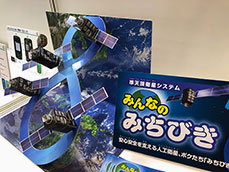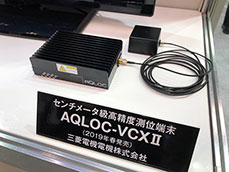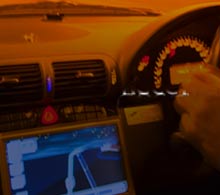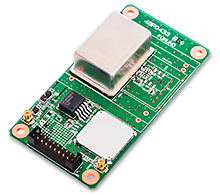Articles for ITS market Drone Business roadmap and updates to Michibiki (Quasi-Zenith Satellite System)
Tendency to invest in services rather than technology
 Full-scale model of "Flying vehicle" shaped like a watercraft.
Full-scale model of "Flying vehicle" shaped like a watercraft.
 Display images of hanging and moving people with a large drone.
Display images of hanging and moving people with a large drone.
Recently media coverage of "Flying vehicles" is increasing worldwide. The Japanese government is also showing positive movements toward the realization of "Flying vehicles". On December 20th, 2018 the market introduction roadmap for "Flying vehicles" was released at the 4th "Public-Private Conference for Future Air Mobility Revolution".
The basic technology of "Flying vehicles" has many common requirements with small drones.
Specifically, both of the aircraft structures are capable of vertical take-off and landing (VTOL: Vertical Takeoff and Landing). It is considered a multicopter and drives multiple propellers with a motor. Also in order to extend the flight distance it is desirable to develop a motor with low power consumption and a small-sized, large-capacity storage battery.
From this point of view the current state of the drone market does not provide much next-generation technology or innovation. Therefore the impression is there are more companies rushing to respond to the service business side rather than technology.
In other words people, goods and money are flowing into business segments that use the current technology due to lack of drone technology innovation.
Business limitations are bottleneck to battery performance
The biggest technical issue is still overall battery performance. It is common to use a lithium ion secondary battery in a drone. As a battery brand Chinese DJI, the largest drone manufacturer uses its own battery. Among Japanese manufacturers Maxell also has a large share.
According to a Maxell representative, Maxell's battery stacks laminated battery cells to form battery modules and battery packs. As demand for drones are still low it has a large, common share with batteries used in nursing care robots.
Maxell's battery pack for drones consists of 6 battery cells in series, with a voltage of 23.12 VDC and the battery capacity of 127 Wh. In consideration of flying the weight is designed to be as light as 0.8 kg.
However the flight time of medium-sized drone even when using the latest battery is still short. For example the flight time of a medium-sized drone with six battery packs and a total weight of 5 kg with a transportable weight of 5 kg is only about 15 minutes.
A drone designer who uses Maxell's battery notes that "Drone flight control is only used for motor control and therefore not technically difficult. The problem is batteries, however battery performance is not expected to increase anytime soon."
He also pointed out that, "After all, I can only build a business within the scope of the current performance. The main fields are surveying, maintenance and inspection. The logistics hurdles are quite high."
The 15 minute business model
At present there are business models that extend past the short flight time, which is the weak point of drones.
For example, Japan Infra Waymark, a subsidiary of NTT West will start operations on April 1, 2019. The sales point of the company is that it can acquire data of drone maintenance inspections. This has been done for NTT West to various infrastructure facilities such as water, gas and electricity. The lower areas such as bridges, wires and pipes of various infrastructures are often grounded and therefore each infrastructure company must conducted maintenance inspections. In recent years companies using drones for infrastructure inspections have been gradually increasing. Converting these into one inspection format can reduce the cost incurred by infrastructure companies.
If they do not use a drone it takes more time and labor, such as a worker visiting a high-level facility. It is also possible that the worker may encounter a dangerous situation depending on the weather or other conditions. Concerned about such a harsh working environment securing workers has become more difficult every year.
In view of such social conditions and industry facts Japan Infra Waymark aims to conduct efficient maintenance inspections by drones in shorter time periods.
A person in charge of Japan Infra Waymark said, "Drone can currently only fly about 15 minutes at a time. However there are only a few places that actually need checking in various infrastructure facilities and we have the know-how and basic data for pinpointing them." He emphasized the business model compensates for the drone's weaknesses.
A new way of life for Quasi-Zenith Satellite Michibiki
An important part of the flight survey related to maintenance and inspection is understanding the position of the drone. GNSS (Global Navigation Satellite System: Satellite Positioning) is the method used. In Japan the use of the quasi-zenith satellite system “Michibiki” has made it possible to maintain high GNSS positioning accuracy when compared to other countries and regions.
In April 2018, the "Michibiki" initial goal was four units for the early stages.Transmission signals are roughly classified into five frequency bands.
The L1 signal is 1575.42 MHz, the L2 signal is 1227.60 MHz, the L5 signal is 1176.45 MHz, the L6 signal is 1278.75 MHz, and the S band signal is 2 GHz.
Main applications for L1 signals are the sub meter-class positioning reinforcement services and also L6 signals for the centimeter-class positioning reinforcement services.
According to a representative of NEC that manufactures the Michibiki system, the sub-meter class is about 1 meter, and the centimeter class is 6 to 12 centimeters. At present the satellite positioning using GPS in the United States and GLONASS in Russia in combination provides position accuracy of around 10 meters. However this largely depends on the reception status of GPS signals or GLONASS signals.
This position accuracy is a numerical value within the plane and the height accuracy is typically about three times less accurate in the plane.
Therefore, in the drone case accuracy of the height, even in the centimeter class is about 18 to 36 cm. Therefore it is necessary to factor these height errors in when carry out the flight maintenance inspection.
Mitsubishi Electric has released AQLOC for high-precision positioning terminals compatible with centimeter-class satellite positioning, and is used for unmanned agricultural tractors. A second-generation AQLOC II, with improved performance will be launched this spring.
Writer introduction

Mr. Kenji Momota Automotive journalist
His major is the world automotive industry and he is also familiar with the energy industry, IT and the aging society problem as the related fields. He acts around the world based in Japan and USA and writes for the general magazines, the technology journals and the automotive related media etc.
He is also commentator of motor race and world's motor show on TV program based on his career of the driver of Indy Racing League and NASCAR. In recent years, he has been covering about a paradigm shift from developed countries to developing countries, the motorized vehicle like EV and the telematics.
FURUNO ITS Journal
Click here for the latest articles after 2022 (in Japanese)2022
- The "realistic" self-driving roadmap shown by the Japanese government and a hands-on report on the latest Subaru EyeSight X
- Will FCVs (Fuel Cell Vehicles) Become Popular? ~New Movement in Toyota and Honda~
- The 'Complete' online sales of new cars start in Japan. Will this new way of buying cars take root?
- Many Firsts! On-Site Report from Tokyo Auto Salon 2022 - The author, who knows what goes on behind the scenes, looks back on 40 years of history. -
2021
- "Moving toward zero traffic fatalities for four-wheeled and two-wheeled vehicles globally in 2050" ~Experience on Honda's latest safety technologies~
- Tsuneishi Shipbuilding's building and DX, an exclusive visit to the main factory
- Japan's Smart City: New Moves toward Practical Use
- When will self-driving buses (service cars) be put to "full-scale" practical use?
- Utilization vehicle data during disasters
- Toyota-led Connected Technology to Transform Commercial Vehicle Business -From light trucks to large trucks and buses-
- Toyota enters the connected car "Personalization" business
- Japanese automakers' carbon-neutral strategies swept up in ESG investment
- Drive experience of the latest autonomous vehicle models and advanced driving support systems
- Will carbon neutrality accelerate the trend to strengthen LCA (Life Cycle Assessment)?
- Semiconductor shortage exposes realities of the automotive industry
- Online Autonomous Driving Contest Enhancing development of Human Resources
2020
- What happens to CASE when gas cars are banned in Japan?
- When will Flying Cars be launched?
- Expectation vs. reality:Autonomous Driving in Japan
- V2X, Becoming increasingly important in autonomous driving
- Technology of Subaru “EyeSight X”
- Lifestyle-oriented French cars gain popularity in Japan
- Human-oriented smart cities are wanted
- MaaS and CASE, how would automotive industry change after COVID-19?
- The beginning of virtualization era, triggered by COVID-19
- Trend of EV shift and consumer demands
- TOYOTA Press conference about ADAS - Releasing algorithm for "sudden acceleration suppression during attempted sudden acceleration" free of charge -
- The Japanese automotive industry in 2020 - 3 turning points -
- "Using a smartphone while driving" and "Level 3 automated driving"
2019
- Motor show business model is at a turning point - Tokyo Motor Show Report -
- Commercialization and monetization of MaaS - ITS World Congress Singapore Report -
- Android Automotive pays attention to V2X - Report from the Frankfurt Motor Show 2019 in Germany -
- Automobile Distribution Revolution and DCM (Data Communication Module)
- Connected business potential and newly proposed "eMaaS" by Honda
- 5G services for practical use are multiplying
- Connectivity technologies attracting attention due to frequent traffic accidents
- Shanghai Motor Show report -SUV, EV, Automated car & 5G-
- Drone Business roadmap and updates to Michibiki (Quasi-Zenith Satellite System)
- MaaS (Mobility as a Service) "town development." Full-scale promotion for a national project
- CES organizer states "Data Period in 2020s." Transformation of the Automotive Industry in CES, US "-CES2019 Report-"
- "Return to Origin" directed towards the age of change, automatic operation and connectivity
2018
- New proposal for Private Car Automated Driving Level and other Hot 5G Technology Topics
- Standardized EV charging infrastructure concerns in Europe, US, Japan and China - Kobe EVS 31 field report -
- Touring a pure car carrier and a test drive of the latest hybrid car
- Planning stage products are exhibited at the newly established visualized mobility service "TOYOTA MOBILITY SHOWROOM".
- Potential “Community Car-share” program promoted by local residents
- CES Asia Report 2108
- Companies attempt new Vehicle-to-Infrastructure communications, including traffic volume measurements and vehicle positioning. -ITS Asia Pacific Forum in Fukuoka-
- Geneva show in Switzerland. Flying cars and MaaS (Mobility as a Service) were hot topics.
- EV (Electric Vehicle) proposals by country
- MaaS competition through service mobilization, M & A and technical field collaboration is accelerating. - The CES 2018 Report -
2017
- Big data’s initiative and fight for the automotive industry. Cooperation among companies becomes increasingly important.
- Connected car and road-to-vehicle communication automatic operation
- ETC (Electronic Toll Collection) and ETC2.0. Current situation and projected future
- Rapid development of sharing economy
- Germany is first to recognize level 3 automated driving
- ITS EU 2017 Field Reports -Automatic Operation and the eCall-
- From Infotainment to ITS, the competitive area is spreading in the car big data industry.
- GTC (GPU Technology Conference) Report and the de facto standardization of AI (artificial intelligence)
- Renesas' new challenge! "e-AI Solution" and "Renesas Autonomy"
- The Automobile industry is shifting from a manufacturing industry to a service industry.
- The movement toward accident countermeasures for aging drivers in Japan
- Fusion of ride sharing and fully automated driving is advancing in the USA.
2016
- Overview of the Quasi-Zenith Satellite System (QZSS) and advancements toward full-scale practical use including the Tokyo Olympic Games - G-space EXPO 2016 report-
- Japan’s automated driving project "SIP-adus" will be a large demonstration experiment.
- The International Home Care & Rehabilitation Exhibition. There were many car manufactures with exhibits booths at this show.
- Japanese car manufacturers starting to concentrate on strengthening the ADAS system
- A new movement of legislation for autonomous cars
- Cyber Security and “AGL”, the new OS for automotive are hot topics in the connected car industry
- “High precision 3D map” the key future of autonomous car and pedestrian dead reckoning
- Chinese “BAT” is accelerating their business in the EV (Electric Vehicle) market
- Tesla's original connection to Taiwan and the new transportation system technologies.
- "The main topic" of the Geneva Motor Show was how to strengthen "pedestrian protection"
- The probe data business is getting more competitive
- Reporting directly from the 2016 CES show "Data services will soon become the main revenue source of automotive industry"
2015
- Do the automated driving systems need the GNSS (Global Navigation Satellite System) ?
- ETC Version 2.0 is coming soon. A new service was announced at the Tokyo Motor Show and the possibility that is could be used as a device for older drivers.
- "Connected Horizon" and "eHorizon". Germany's leading parts supplier accelerates strengthening of "Big Data" for business



 Maxell's lithium-ion rechargeable battery pack for drone
Maxell's lithium-ion rechargeable battery pack for drone NTT DoCoMo exhibited a system for grasping the flight status of a drone by mounting a camera monitor on its head.
NTT DoCoMo exhibited a system for grasping the flight status of a drone by mounting a camera monitor on its head. Japan Infra Waymark’s exhibition booth.
Japan Infra Waymark’s exhibition booth. Exhibit on Quasi-Zenith Satellite Michibiki.
Exhibit on Quasi-Zenith Satellite Michibiki. Mitsubishi Electric's high-precision positioning terminal AQ LOC's second-generation product that receives Michibiki's L6 signal
Mitsubishi Electric's high-precision positioning terminal AQ LOC's second-generation product that receives Michibiki's L6 signal GPS/GNSS Receiver&Chips and Modules (positioning and timing)
GPS/GNSS Receiver&Chips and Modules (positioning and timing)